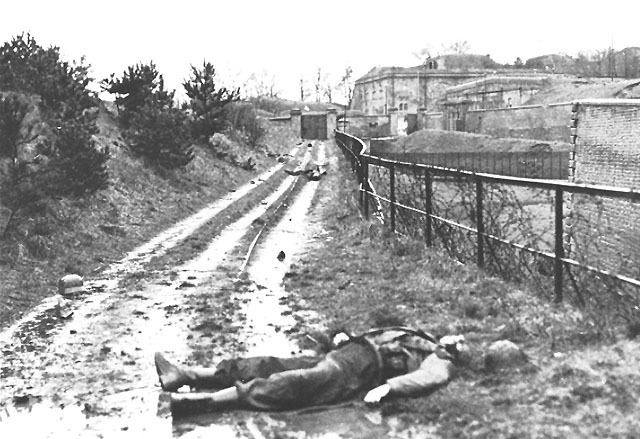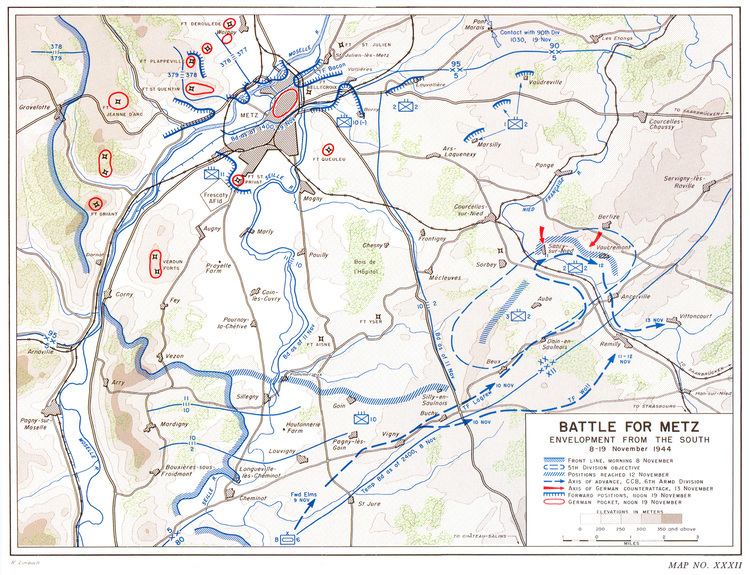Result American victory | ||
 | ||
Period September 1944 – December 1944 Similar | ||
Ww2 the battle of metz 1944 the iron men of metz full documentary
The Battle of Metz was a battle fought during World War II at the city of Metz, France, from late September 1944 through mid-December between the U.S. Third Army commanded by Lieutenant General George Patton and the German Army commanded by General Otto von Knobelsdorff. Strong German resistance resulted in heavy casualties for both sides. The city was captured by U.S. forces and hostilities formally ceased on November 22; the last of the forts defending Metz surrendered on December 13.
Contents
- Ww2 the battle of metz 1944 the iron men of metz full documentary
- Background
- Battle
- Aftermath
- References

Background

Metz is located between the rivers Moselle and Seille. The fortifications of Metz consisted of several forts and observation posts with connecting entrenchments and tunnels. The city had fallen to the German forces when France was defeated in 1940. Following the fall of France, the city was immediately annexed to the Third Reich. Most of the Nazi dignitaries assumed it was obvious that Metz, where so many German army officers were born, was a German city. At that time, the Wehrmacht did not consider it an important location and the city's defenses were reduced with many guns and equipment removed.

However, as the Allied forces advanced rapidly into German-held territory following the Normandy landings, Metz became an important location for the German command to organize its defenses and attempt to contain the Allied advance. By the end of August 1944, German forces in Lorraine had managed to reestablish a defensive line and the U.S. Third Army had come to a halt in face of the German defenses, resulting in a brief pause of operations in this area of the western front. According to an order issued by Hitler in March 1944, fortress commanders were ordered to allow their forts to be surrounded if necessary and hold them, surrendering only with Hitler's approval. Metz was required to follow this order by early September, since the U.S. Third Army led by General George S. Patton had reached Verdun and was posing a threat to the Sarre region of Germany. The German command intended to obtain more time for the strengthening of the West Wall through this strategy. The defense was undertaken by the German First Army, commanded by General Otto von Knobelsdorff. The number of German troops positioned in the vicinity of Metz was equivalent to four and a half divisions.
Battle
Armoured cavalry elements of the United States XX Corps, while on a reconnaissance operation in the direction of the Moselle, made contact with elements from the 17th SS Panzergrenadier Division on 6 September 1944. On 18 September, U.S. reconnaissance units encountered Wehrmacht Panzergrenadiers again. The U.S. forces had not expected the German forces to be in the area, and had to bring together their units that were spread out. Several small scale attacks were made by the U.S. forces after this encounter.
The first U.S. attack was launched by the 5th Infantry Division, in which they attempted to capture a bridgehead to the north of Metz. This attack was repelled by the German forces, as was another attack on the city that followed. In another attack, the US forces captured a small bridgehead across the Moselle to the south of Metz.
By the end of September, German forces positioned to the north were relocated in the southern area of Metz. A number of troops were also withdrawn from Metz. Following this new development, the XII Corps launched another attack but was countered by the German defenders. In the following two weeks, the U.S. forces limited themselves to small scale attacks and patrolling in the Metz area. During this time, the XX Corps underwent a training program, experimenting with methods of reducing the defenses of the fortress. By this time, the U.S. command had decided to attack Metz from its rear, coming from the east.
On November 3, a new attack was launched by the U.S. forces, which resulted in the capture of the outer defenses with the aid of the tactics developed during the training process. On November 14, Generalleutnant Heinrich Kittel was appointed as the new commander of the German forces. By 17 November, U.S. forces had managed to isolate most of the forts, and were attacking the city. German forces had been retreating since November 17, and U.S. forces pursued them for the following two days. U.S. forces entered Metz on November 18, and on November 21, Kittel was wounded and subsequently captured. Although the city itself was captured by U.S. forces and hostilities formally ceased on November 22, the remaining isolated forts continued to hold out.
Direct assault was forbidden against the holdout forts in order to preserve artillery ammunition for the XX Corps' advance to the Sarre River and the isolated forts subsequently surrendered one by one following the surrender of Fort Verdun on November 26. By the end of November, several forts were still holding out. The last of the forts at Metz to surrender was Fort Jeanne d'Arc, on December 13.
Aftermath
Although the battle resulted in defeat for the German forces, it served the intended purpose of the German command of halting the advance of the U.S. Third Army for three months, enabling retreating German forces to make an organized withdrawal to the Sarre river and to organize their defenses. The estimation of casualties for both sides are unknown but high.
